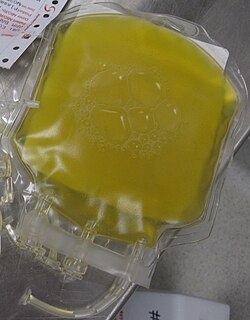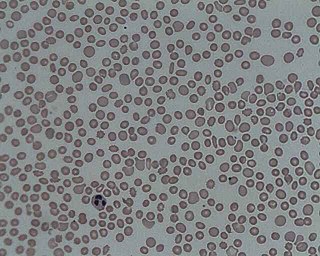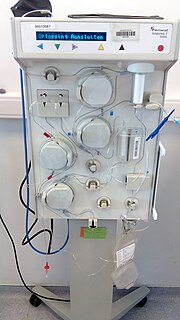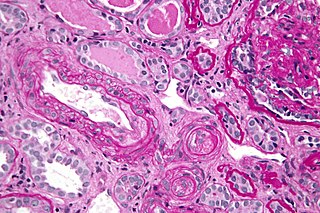Related Research Articles

Platelets, also called thrombocytes, are a component of blood whose function is to react to bleeding from blood vessel injury by clumping, thereby initiating a blood clot. Platelets have no cell nucleus; they are fragments of cytoplasm that are derived from the megakaryocytes of the bone marrow or lung, which then enter the circulation. Circulating inactivated platelets are biconvex discoid (lens-shaped) structures, 2–3 µm in greatest diameter. Activated platelets have cell membrane projections covering their surface. Platelets are found only in mammals, whereas in other vertebrates, thrombocytes circulate as intact mononuclear cells.

Coagulation, also known as clotting, is the process by which blood changes from a liquid to a gel, forming a blood clot. It potentially results in hemostasis, the cessation of blood loss from a damaged vessel, followed by repair. The mechanism of coagulation involves activation, adhesion and aggregation of platelets, as well as deposition and maturation of fibrin.

Blood plasma is a light amber-colored liquid component of blood in which blood cells are absent, but contains proteins and other constituents of whole blood in suspension. It makes up about 55% of the body's total blood volume. It is the intravascular part of extracellular fluid. It is mostly water, and contains important dissolved proteins, glucose, clotting factors, electrolytes, hormones, carbon dioxide, and oxygen. It plays a vital role in an intravascular osmotic effect that keeps electrolyte concentration balanced and protects the body from infection and other blood-related disorders.

Disseminated intravascular coagulation (DIC) is a condition in which blood clots form throughout the body, blocking small blood vessels. Symptoms may include chest pain, shortness of breath, leg pain, problems speaking, or problems moving parts of the body. As clotting factors and platelets are used up, bleeding may occur. This may include blood in the urine, blood in the stool, or bleeding into the skin. Complications may include organ failure.

Immune thrombocytopenic purpura (ITP), also known as idiopathic thrombocytopenic purpura or immune thrombocytopenia, is a type of thrombocytopenic purpura defined as an isolated low platelet count with a normal bone marrow in the absence of other causes of low platelets. It causes a characteristic red or purple bruise-like rash and an increased tendency to bleed. Two distinct clinical syndromes manifest as an acute condition in children and a chronic condition in adults. The acute form often follows an infection and spontaneously resolves within two months. Chronic immune thrombocytopenia persists longer than six months with a specific cause being unknown.

Thrombotic thrombocytopenic purpura (TTP) is a blood disorder that results in blood clots forming in small blood vessels throughout the body. This results in a low platelet count, low red blood cells due to their breakdown, and often kidney, heart, and brain dysfunction. Symptoms may include large bruises, fever, weakness, shortness of breath, confusion, and headache. Repeated episodes may occur.

Thrombocytopenia is a condition characterized by abnormally low levels of platelets, also known as thrombocytes, in the blood. It is the most common coagulation disorder among intensive care patients and is seen in 20% of medical patients and a third of surgical patients.
Cryoprecipitate, also called cryo for short, is a frozen blood product prepared from blood plasma. To create cryoprecipitate, fresh frozen plasma thawed to 1–6 °C is then centrifuged and the precipitate is collected. The precipitate is resuspended in a small amount of residual plasma and is then re-frozen for storage. It is often transfused to adults as two 5-unit pools instead of as a single product. One of the most important constituents is factor VIII, which is why cryoprecipitate is sometimes called cryoprecipitated antihaemophilic factor or cryoprecipitated AHF. In many clinical contexts, use of whole cryoprecipitate has been replaced with use of clotting factor concentrates made therefrom, but the whole form is still routinely stocked by many, if not most, hospital blood banks. Cryo can be stored at −18 °C or colder for 12 months from the original collection date. After thawing, single units of cryo can be stored at 20–24 °C for up to 6 hours. If units of cryo are pooled in an open system, they can only be held at 20–24 °C for up to 4 hours. Presently cryo cannot be re-frozen for storage after it is thawed for use if it is not transfused.

Plasmapheresis is the removal, treatment, and return or exchange of blood plasma or components thereof from and to the blood circulation. It is thus an extracorporeal therapy.

Plateletpheresis is the process of collecting thrombocytes, more commonly called platelets, a component of blood involved in blood clotting. The term specifically refers to the method of collecting the platelets, which is performed by a device used in blood donation that separates the platelets and returns other portions of the blood to the donor. Platelet transfusion can be a life-saving procedure in preventing or treating serious complications from bleeding and hemorrhage in patients who have disorders manifesting as thrombocytopenia or platelet dysfunction. This process may also be used therapeutically to treat disorders resulting in extraordinarily high platelet counts such as essential thrombocytosis.

ADAMTS13 —also known as von Willebrand factor-cleaving protease (VWFCP)—is a zinc-containing metalloprotease enzyme that cleaves von Willebrand factor (vWf), a large protein involved in blood clotting. It is secreted into the blood and degrades large vWf multimers, decreasing their activity.

Fresh frozen plasma (FFP) is a blood product made from the liquid portion of whole blood. It is used to treat conditions in which there are low blood clotting factors or low levels of other blood proteins. It may also be used as the replacement fluid in plasma exchange. Using ABO compatible plasma, while not required, may be recommended. Use as a volume expander is not recommended. It is given by slow injection into a vein.
Congenital afibrinogenemia is a rare, genetically inherited blood fibrinogen disorder in which the blood does not clot normally due to the lack of fibrinogen, a blood protein necessary for coagulation. This disorder is autosomal recessive, meaning that two unaffected parents can have a child with the disorder. The lack of fibrinogen expresses itself with excessive and, at times, uncontrollable bleeding.

Thrombotic microangiopathy (TMA) is a pathology that results in thrombosis in capillaries and arterioles, due to an endothelial injury. It may be seen in association with thrombocytopenia, anemia, purpura and kidney failure.
Purpura fulminans is an acute, often fatal, thrombotic disorder which manifests as blood spots, bruising and discolouration of the skin resulting from coagulation in small blood vessels within the skin and rapidly leads to skin necrosis and disseminated intravascular coagulation.
A blood product is any therapeutic substance prepared from human blood. This includes whole blood; blood components; and plasma derivatives. Whole blood is not commonly used in transfusion medicine. Blood components include: red blood cell concentrates or suspensions; platelets produced from whole blood or via apheresis; plasma; and cryoprecipitate. Plasma derivatives are plasma proteins prepared under pharmaceutical manufacturing conditions, these include: albumin; coagulation factor concentrates; and immunoglobulins.
Plasma frozen within 24 hours after phlebotomy, commonly called FP24, PF‑24, or similar names, is a frozen human blood plasma product used in transfusion medicine. It differs from fresh-frozen plasma (FFP) in that it is frozen within 24 hours of blood collection, whereas FFP is frozen within 8 hours. The phrase "FFP" is sometimes used to refer to any frozen blood plasma product intended for transfusion.
Caplacizumab is a bivalent single-domain antibody (VHH) designed for the treatment of thrombotic thrombocytopenic purpura and thrombosis.

Jeanne Marie Lusher, M.D. was an American physician, pediatric hematologist/oncologist, and a researcher in the field of bleeding disorders of childhood, and has served as the director of Hemostasis Program at the Children's Hospital of Michigan until her retirement on June 28, 2013.

Upshaw–Schulman syndrome (USS) is the recessively inherited form of thrombotic thrombocytopenic purpura (TTP), a rare and complex blood coagulation disease. USS is caused by the absence of the ADAMTS13 protease resulting in the persistence of ultra large von Willebrand factor multimers (ULVWF), causing episodes of acute thrombotic microangiopathy with disseminated multiple small vessel obstructions. These obstructions deprive downstream tissues from blood and oxygen, which can result in tissue damage and death. The presentation of an acute USS episode is variable but usually associated with thrombocytopenia, microangiopathic hemolytic anemia (MAHA) with schistocytes on the peripheral blood smear, fever and signs of ischemic organ damage in the brain, kidney and heart.
References
- 1 2 Shaz, Beth H.; Hillyer, Christopher D.; Roshal, Mikhail; Abrams, Charles S. (2013). Transfusion Medicine and Hemostasis: Clinical and Laboratory Aspects. Newnes. p. 211. ISBN 9780123977885.
- ↑ Shehata, N., Blajchman, M. & Heddle, N. (21 Dec 2001). "Coagulation factors in fresh frozen plasma (FFP) and cryosupernatant (CSP) plasma (Abstract, in Abstracts of papers presented at the Joint Scientific Conference of the Canadian Society for Transfusion Medicine and Canadian Blood Services, 10–13 May 2001)". Transfusion Medicine. 11 (5): 391–401. doi:10.1046/j.1365-3148.2001.00115.x.
{{cite journal}}: CS1 maint: multiple names: authors list (link) - ↑ Canadian Blood Services (2004). "F. Cryosupernatant, Leucocytes Reduced (LR)" (PDF). 2004 Circular of Information (PDF). p. 49. Retrieved December 2, 2009.